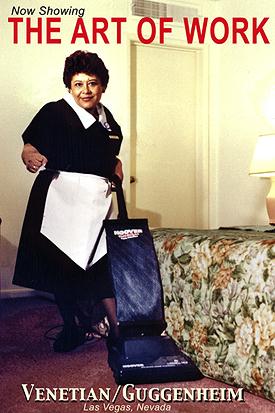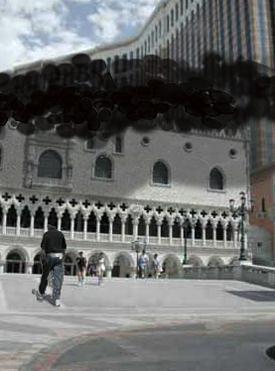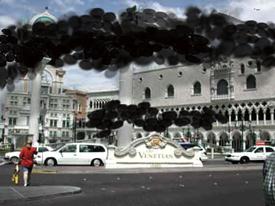Still Learning From Las Vegas
Sara Lewison
FOR IMMEDIATE RELEASE
Saturday, September 16, 2001
Las Vegas, Nevada
"In support of today's protest by the Las Vegas Culinary Union against
the Venetian Hotel Casino's anti-union activities, two Los Angeles
artists are casting a shadow on the new Guggenheim Museum. The opening
ceremonies for Las Vegas' newest institution of high art at the Venetian
Hotel Casino take off this afternoon, but the motif of counter-celebration
is already hanging in the sky. A "Black Cloud" is hovering over the
museum today as members of the Culinary Union gather to protest union-busting
by the Venetian. This "cloud" of over 1000 balloons is being called
a sign of symbolic mourning for the Guggenheim's passive compliance
with the Venetian Hotel Casino's anti-union campaign. Artists Nicole
Cousino and Sarah Lewison predict further bad weather for Las Vegas,
if contracts like the one the Venetian has made with the Guggenheim
are going to be the centerpiece of the city's program to bring in
high art."
 |
|
It seems surprising that a city such as Las Vegas, with an economy
centered on dragging folks in on the promise of a jackpot, is also
a union town. Vegas is one of the few American cities where everyone
knows what a union is, and the Hotel Employee and Restaurant Employees
International (aka the Culinary Union) is one of the more powerful
union. With over 55,000 members, HERE has political alliances, attentive
media coverage and police protection for rallies. Their members are
housekeepers, busboys and cooks who provide services from making change
to placing mints on the pillows. Although theirs is the least visible
labor on the Strip, they have successfully organized all but two casinos.
One of the holdouts is the Venetian, which continues to rebuff efforts
by HERE to unionize their workers. When the Venetian announced their
lucrative partnership with the Guggenheim, offering space to build
two new museums in return for lease fees and a share of profits, HERE
attempted to steer the Guggenheim to consider alternative unionized
properties for the venture. Given the experience of the museum at
the Bellagio, the Venetian was likely to increase annual profits by
several million. This past September, HERE sought to use the Guggenheim's
opening as an occasion to expose the museum’s disregard for the
union's long-term dispute with the Venetian. To accomplish this exposé,
they asked several artists to design and implement elements for their
rally.
HERE felt that Venetian owner Sheldon Adelson was using art to raise
the value of his property through cultural cache and increased foot
traffic and HERE wanted to usurp this artistic appropriation through
their own visual display. As artists interested in spectatorship and
civic space, Nicole Cousino and I were eager to work in Las Vegas,
a city that flaunts the potential and superficiality of wealth. The
campaign offered an opportunity to examine relations between labor,
capital and art under superlative circumstances. Even though the event
was cancelled due to the events of9/11, the collaboration raises questions
about the relations between art and labor in a service economy.
The Culinary Union had been picketing sporadically
in front of the Venetian for three years with the goals of building
worker solidarity, dissuading Venetian customers, and pressuring the
Venetian's owners into accepting unionization. Our proposed cloud
project was intended to direct attention from the Venetian's facade
and toward a large rally that would include a medley of events, performances,
pickets and other artist projects. While the black cloud referred
directly to the stand-off between the union and the Venetian, it was
also to be contextualized as implicit institutional critique by its
sheer proximity to the art Institution.
It is significant that the institution in question here was the (Mc)Guggenheim
Vegas, currently exhibiting the BMW-sponsored "Art of the Motorcycle."
Their other recent traveling show, "Georgio Armani," was sponsored
by the Time Warner magazine "In Style," yet was certainly enriched
by the $15 million gift Armani made to the museum. These kinds of
exhibits are effectively advertising-elevated-to-the-position-of-high-art,
with imaginably correlative economic benefits for the companies whose
wares are on display.
The franchising of museums like the Guggenheim is of-a-piece with
the franchising of other upscale commercial outlets (Starbucks, Gap)
throughout the world. In this case, corporate economic globalization
not only exploits weak labor and environmental standards in poorer
countries, but also opens up new sites in low-rent cities for museum
branches, or 'franchises' like the Guggenheim. Their low-overhead
pre-packaged shows tend to steal audiences away from local institutions,
while contributing to the global homogenization and commercialization
of cultural exhibitions. Much like McDonald's has done, the Guggenheim's
director Thomas Kren anticipates further international incursions,
including branches in South America, East Asia, South Asia, the Middle
East, and Africa.
| |
 |
As a career move, a commission from a union does not have the prestige
of one from a museum, but we relished the notion that our labor might
contribute to the economic justice for workers in an(other) underpaid
occupation. Below the black cloud, we envisioned a choreographed flotilla
of gondolas on the sidewalk filled with union members singing about
what it takes to keep the Venetian's own gondolas afloat. A set of
informative commemorative postcards would be distributed to tourists,
and an authentic Venetian Gondolier's Union representative would appear
at the rally. At the time the event was cancelled, we were negotiating
a proposed infiltration of custom napkins into the Guggenheim's opening
reception, printed with a broken heart with 'labor' on one side, and
'art' on the other.
Our proposed activities were all subject to approval by HERE's lawyers
and the lead organizer. These negotiations kept alive the sense that
our participation in this campaign was mercenary, that we would move
on to other projects while this struggle for union recognition would
continue. At this moment, our focus was upon this group of workers,
to whom we were brokering our labor and ideas, but the next moment,
we might be pursuing a different agenda. Underlying this sense of
the mercenary was a recognition of the convoluted way the logic of
artistic autonomy functions to conceal our economic and social dependence
upon authorities that confer status and value upon artistic practice.
The lead organizer did not respond positively to the napkins, saying
he didn't understand the connection between art and labor. Had we
been in direct discussion with him (all conversations took place through
an intermediary), we could have pointed out historic examples of art's
collusion with social justice, such as Diego Rivera and the WPA. In
lieu of debate, we turned these concerns back into our project by
seeking to define distinctions between the union's and our domains
of interest. For example, the union was primarily concerned with its
members' sense of commitment and solidarity, manifested by a kind
of outing of Adelson's unfair labor practices. While supporting the
union in their focus we were also interested in creating a larger
public support and understanding of the issues. In the commemorative
postcards we designed, we insisted on balancing the union's agitation
with a second text that explained why unionization is good for the
workers and for a city.
In reflection, there are connections to be drawn between the service
industry and some contemporary artistic practices. HERE's large size
reflects a surge in employment in the service sector countering a
decrease in manufacturing in developed nations. It has been observed
that, correlating to the growth of the service sector, there has also
been an increase in artistic practices that involve expenditures of
labor in excess of material production. In her article "How to Provide
an Artistic Service," Andrea Fraser characterizes these as practices
that in economic terms would be called service provision. These include
artists engaged in institutional critique, in orchestrating meetings
and experiences for the spectator (Maria Karlsson), in the provision
of food (Rikrit Tiravanija), drinks or music, site interpretation
and analysis (CLUI), advocacy and community education (Guerrilla Girls,
Gran Fury), and the development of new social and economic structures
(Art in Action, N55, @rtmark).
What is the situation of the service provider? Unlike artists who
produce objects that acquire an economic value as luxury commodities,
service providers either need to survive upon payment for their services
or by an outside source of income. In the machine of exhibition, criticism
and investment, value and prestige are highly wrapped up in a disinterest
as to the social use value of an object or artistic action. Institutions
act to objectify art, so that it is presented as the output of creators
operating as autonomous agents of their own desire and interests.
 |
|
This transformation of personal value and
labor into symbolic value casts a blind eye to the particular genre’s
form, but objects and actions lead different lives in the world of
exchange. Ultimately however, is the service-providing artist providing
any service other then accrual of prestige for the institution?
In Las Vegas, what was our relationship
with the union? Was it a collaboration, a parasitic relationship;
were we being called in like plumbers or specialty surgeons to provide
a service? Considering the discrepancies in power and focus between
us and HERE, it seems difficult to call this a collaboration. Technically,
we were contracted specialists, whose job was to fine-tune the union's
public relations vis-a-vis the Guggenheim campaign. We were providing
a service, yes, but one that was consonant with our own desires for
social discourse.
Like entrepreneurs or effective unions, we sought to shape our participation
in this project so as to maintain control over its use and meaning.
We wanted to create an affective image/moment that would resonate
autonomously, and we also chose to aid the Culinary local (HERE) in
their cause. It would be worthwhile to examine the ways contemporary
artists retain control over how their art is used, in an attempt to
produce collectivity, autonomy and agency in the midst of a speculative
international market.
As long as the system of belief on which the status of our activity
depends is defined according to a principle of autonomy which bars
us from pursuing the production of specific social use value, we are
consigned to producing only prestige value."Andrea Fraser, "How to
Provide an Artistic Service"



